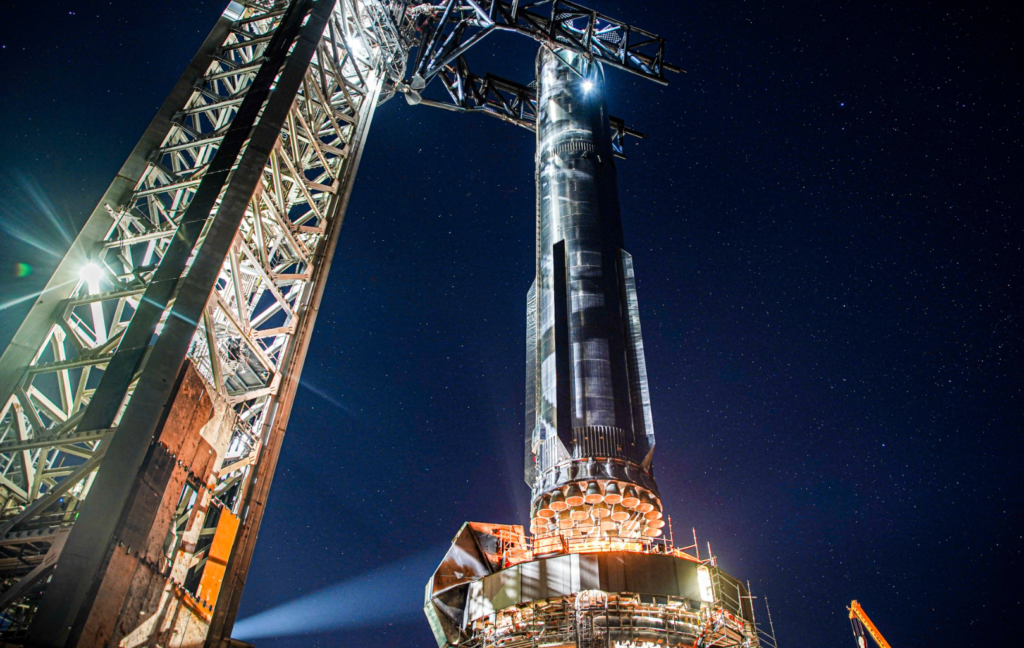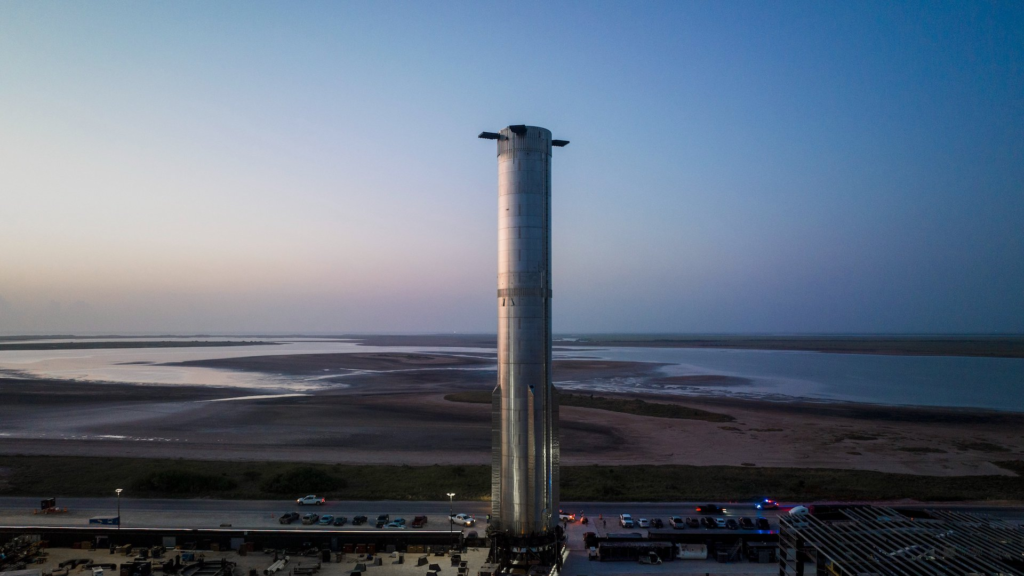
SpaceX’s Pad Upgrades Are About To Be Tested
As SpaceX prepares for the second orbital test flight of Starship, the company is doing a few things differently than the first time. This not only includes physical changes to the booster and pad protection, but also some of the pre launch testing. Prior to the first integrated test flight, SpaceX did a partial thrust static fire of the booster.
This test ended up giving the company a false sense of confidence in regard to the strength of the launch infrastructure and pad in particular. Now with a full water-cooled steel plate installed, the company is about to attempt the first static fire with these changes. Depending on the results, we could see a launch in the very near future.
With this in mind, the test will likely still be a partial thrust static fire for a few different reasons. Here I will go more in-depth into the upcoming test, the upgraded pad systems, what to expect in the coming weeks, and more.
Upcoming Tests

All signs are pointing to a Starship Booster 9 static fire in the coming weeks. Most recently on the 21st, SpaceX tweeted saying, “Booster 9 on the pad”. With the booster now in place, the company will prepare both the rocket and general pad systems for a 33-engine static fire. This time, however, they will be paying extra close attention to the strength and effectiveness of the newly installed pad protection.
Right after the first Starship launch, Elon was quoted saying, “3 months ago, we started building a massive water-cooled, steel plate to go under the launch mount. Wasn’t ready in time & we wrongly thought, based on static fire data, that Fondag would make it through 1 launch.” This highlights that the company believed the special heat-resistant concrete used below the pad would hold up for at least a single launch. It held up quite well to a 31 Raptor engine static fire months before the launch, however, that test was only using partial thrust. When the full thrust of Starship contacted the ground for around 8 seconds, the concrete was not able to withstand it.
Even after that 31 engines static fire, there were a few signs that the current pad systems at the time might not be strong enough. For example, even though after the static fire the pad wasn’t destroyed, there was still a decent amount of damage and debris that flew all over. This time around, SpaceX will make sure that even with a partial thrust static fire, the pad is ready and shows very little if any signs of weakness.
All this being said, the current water-cooled steel plate is a significant upgrade from the special concrete and is even considered overkill by the company. In a quote Musk said, “We’re actually going for overkill on the steel sandwich and the concrete, so that should leave the base of the pad in much better shape than the last time” he said. Not to mention it’s already been undergoing tests for the past few months. Months ago in May, SpaceX released video of a Raptor igniting and shooting its exhaust straight into the center of a nearby steel plate propped up vertically. It’s very likely that tests exactly like this one have been going on for months now.
Focusing more on the test footage itself, it highlights the immense power of the Raptor engine and gives an idea of what the company is up against. While the video cuts off right after the Raptor stops firing, you can see that the plate is still standing and looks to be intact. Obviously, this is only a single Raptor and not 33, but you have to consider the extra surface area and size of a full water-cooled steel plate and also the distance. In the test footage based on the Raptor size, the steel test plate looks to be around 7 meters away from the engine. This is a much closer distance than the space between the top of the Orbital Launch Mount and the ground where a full plate will be installed. In reality, the distance will be around twice this at close to 15 meters.
On the upcoming static fire, we can expect the steel plate to hold up very well. SpaceX learned its lesson on the first launch and has already implemented a strong solution that they believe is enough to handle 33 Raptor engines. It’s also important to point out that the actual launch attempt should put less stress on the pad than the first flight. Elon was quoted saying, “For the next flight, “we’re going to start the engines faster and get off the pad faster.” From engine start to moving Starship “was around 5 seconds, which is a really long time to be blasting the pad.” Going to try to cut that time in half” he said. This could help avoid damage as less stress is put on the pad for a given amount of time.
Booster Upgrades

While the pad has been an area of focus for the company recently, so has the booster. The booster that will soon be tested and eventually launch on the next flight is Booster 9. Just looking at the exterior of it shows some significant upgrades from the past versions. New images from SpaceX highlight the extra protection and upgraded engine skirt toward the bottom of the booster. In reality, these are small changes compared to the long list of other improvements made.
Musk said SpaceX made a “tremendous number” of other changes to the vehicle, “well over a thousand.” He also talked about the Raptor engines and SpaceX described the first Starship integrated launch vehicle as using a “hodgepodge” of engines built over time. The Raptors on the new vehicles include changes to the hot gas manifold in the engine to reduce fuel leakage.
Starship’s first test flight was with Booster 7 and Ship 24. Even before the first launch, in an interview, Elon was quoted saying, “We are actually dying to get this rocket off no matter what happens to it because there are so many improvements between booster 7 and booster 9, literally hundreds. Some major ones, we moved from hydraulic thrust vector control to electric, and the entire heat shield structure on the base on Booster 9 is completely redesigned from Booster 7. Booster 7 has kinda a retrofitted heat shield system between the engines”.
Interestingly, a lot of the information and changes that Elon stated prior to the launch, were very relevant during the actual attempt and first flight of Starship. For example, in another interview with Musk, he commented, “Rocket kept going through T+62 seconds” with the engines continuing to run. Lost thrust vector control at T+85 seconds.” Big thing for the next Starship launch is “ensuring that we don’t lose thrust vector control” with Booster 9. We got pretty close to stage separation … if we had maintained thrust vector control and throttled up, which we should have … then we would have made it to staging” he pointed out.
To add to this, the other big changes that he mentioned before the launch had to do with the booster heat shield and the Raptor engines being like a box of grenades. On Starship’s recent flight, we saw some small explosions with the engines during flight and the eventual loss of multiple Raptors. Elon was quoted after the mission saying, ” At T+27 seconds, SpaceX lost communications due to “some kind of energy event.” And “some kind of explosion happened to knock out the heat shields of engines 17, 18, 19, or 20.” This comment from Musk highlights the correlation and value of these changes. In this case, improvements were specifically made to Booster 9 related to this exact problem and protecting the Raptor engines at the base of the rocket.
If the changes mentioned weren’t enough, Elon talked more about the improvements when he said, “The big things that are important for the next flight are, ensuring that we don’t lose thrust vector control, so isolating that thrust vector control. With Booster 9 that is a lot easier because we use electric motors to steer the engines as opposed to hydraulic actuators where you have a common manifold between the hydraulic actuators. In this case, if you lose hydraulic pressure you can lose multiple engines. The electrically actuated engines will be much more isolated and not have like a single event failure as long as they don’t lose power or coms” he said.
As far as the future schedule, SpaceX and Elon are ambitious. Elon was quoted saying, “Well, I’m hopeful we can get four flights out this year maybe 5. I would be surprised if we exit this year without getting to orbit. Probably an 80% probability of reaching orbit with Starship this year, and “I think close to 100% chance of reaching orbit within 12 months. SpaceX is quite good at production, like the best in history of any rocket production. I mean we are making a Falcon 9 upper stage which is a large complex machine every 3 or 4 days. We even slowed down Raptor engine production “because we’ve got more Raptors than we know what to do with” he commented.
This statement tells us a lot about what to expect in the near future. For one, it’s obvious the thing holding SpaceX back from launching again is not the production aspect. In regard to this, the main limiting factors are pad work, which seems to be making very fast progress, and vehicle testing which will begin very soon. He also is confident that they will perform another 4 launches this year. No matter what, the next launch is making great progress and should occur within the next few months.
Conclusion
SpaceX is getting close to its second test flight as it prepares for a Booster 9 static fire. This will not only test the upgraded booster hardware but also the new water-cooled steel plate on the pad. Both are important for the success of the next integrated test flight. We will have to wait and see how it progresses and the impact it has on the space industry.
